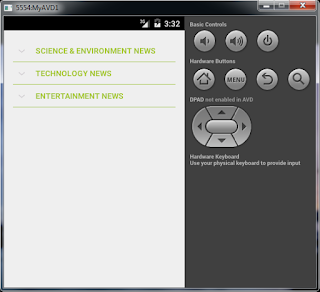ExpandableListView is an Android container available as
part of the platform. It will be useful to display grouped set of
items. On click of the group titles the child elements will be expanded.
Sample Code:
File: activity_main.xml
<RelativeLayout xmlns:android="http://schemas.android.com/apk/res/android" xmlns:tools="http://schemas.android.com/tools" android:layout_width="match_parent" android:layout_height="match_parent" android:paddingLeft="@dimen/activity_horizontal_margin" android:paddingRight="@dimen/activity_horizontal_margin" android:paddingTop="@dimen/activity_vertical_margin" android:paddingBottom="@dimen/activity_vertical_margin" tools:context="com.javapapers.android.expandablelistview.app.MainActivity">
<ExpandableListView android:id="@+id/expandableListView" android:layout_height="match_parent" android:layout_width="match_parent" android:indicatorLeft="?android:attr/expandableListPreferredItemIndicatorLeft" android:divider="#A4C739" android:dividerHeight="0.5dp" />
</RelativeLayout>
File: list_group.xml
<?xml version="1.0" encoding="utf-8"?>
<LinearLayout xmlns:android="http://schemas.android.com/apk/res/android"
android:orientation="vertical" android:layout_width="match_parent"
android:layout_height="match_parent">
<TextView
android:id="@+id/listTitle"
android:layout_width="fill_parent"
android:layout_height="wrap_content"
android:paddingLeft="?android:attr/expandableListPreferredItemPaddingLeft"
android:textColor="#A4C739"
android:paddingTop="10dp"
android:paddingBottom="10dp" />
</LinearLayout>
File: list_item.xml
<?xml version="1.0" encoding="utf-8"?>
<LinearLayout xmlns:android="http://schemas.android.com/apk/res/android"
android:orientation="vertical" android:layout_width="match_parent"
android:layout_height="wrap_content">
<TextView
android:id="@+id/expandedListItem"
android:layout_width="fill_parent"
android:layout_height="wrap_content"
android:paddingLeft="?android:attr/expandableListPreferredChildPaddingLeft"
android:paddingTop="10dp"
android:paddingBottom="10dp" />
</LinearLayout>
File: MainActivity.java
package com.sneha.expandablelistview;
import java.util.ArrayList;
import java.util.HashMap;
import java.util.List;
import android.app.Activity;
import android.os.Bundle;
import android.view.View;
import android.widget.ExpandableListView;
import android.widget.ExpandableListView.OnChildClickListener;
import android.widget.ExpandableListView.OnGroupCollapseListener;
import android.widget.ExpandableListView.OnGroupExpandListener;
import android.widget.Toast;
public class MainActivity extends Activity
{
ExpandableListView expandableListView;
ExpandableListAdapter expandableListAdapter;
List<String> expandableListTitle;
HashMap<String, List<String>> expandableListDetail;
@Override
protected void onCreate(Bundle savedInstanceState)
{
super.onCreate(savedInstanceState);
setContentView(R.layout.activity_main);
expandableListView = (ExpandableListView) findViewById(R.id.expandableListView);
expandableListDetail = ExpandableListDataPump.getData();
expandableListTitle = new ArrayList<String>(expandableListDetail.keySet());
expandableListAdapter = new ExpandableListAdapter(this, expandableListTitle, expandableListDetail);
expandableListView.setAdapter(expandableListAdapter);
expandableListView.setOnGroupExpandListener(new OnGroupExpandListener()
{
@Override
public void onGroupExpand(int groupPosition)
{
Toast.makeText(getApplicationContext(), expandableListTitle.get(groupPosition) + " List Expanded.", Toast.LENGTH_SHORT).show();
}
});
expandableListView.setOnGroupCollapseListener(new OnGroupCollapseListener()
{
@Override
public void onGroupCollapse(int groupPosition)
{
Toast.makeText(getApplicationContext(), expandableListTitle.get(groupPosition) + " List Collapsed.", Toast.LENGTH_SHORT).show();
}
});
expandableListView.setOnChildClickListener(new OnChildClickListener()
{
@Override
public boolean onChildClick(ExpandableListView parent, View v, int groupPosition, int childPosition, long id)
{
Toast.makeText(getApplicationContext(), expandableListTitle.get(groupPosition)
+ " -> " + expandableListDetail.get(expandableListTitle.get(groupPosition)).
get(childPosition), Toast.LENGTH_SHORT).show();
return false;
}
});
}
}
File: ExpandableListAdapter.java
package com.sneha.expandablelistview;
import java.util.HashMap;
import java.util.List;
import android.content.Context;
import android.graphics.Typeface;
import android.view.LayoutInflater;
import android.view.View;
import android.view.ViewGroup;
import android.widget.BaseExpandableListAdapter;
import android.widget.TextView;
public class ExpandableListAdapter extends BaseExpandableListAdapter
{
private Context context;
private List<String> expandableListTitle;
private HashMap<String, List<String>> expandableListDetail;
public ExpandableListAdapter(Context context, List<String> expandableListTitle, HashMap<String, List<String>> expandableListDetail)
{
this.context = context;
this.expandableListTitle = expandableListTitle;
this.expandableListDetail = expandableListDetail;
}
@Override
public Object getChild(int listPosition, int expandedListPosition)
{
return this.expandableListDetail.get(this.expandableListTitle.get(listPosition)).get(expandedListPosition);
}
@Override
public long getChildId(int listPosition, int expandedListPosition)
{
return expandedListPosition;
}
@Override
public View getChildView(int listPosition, final int expandedListPosition, boolean isLastChild, View convertView, ViewGroup parent)
{
final String expandedListText = (String) getChild(listPosition, expandedListPosition);
if (convertView == null)
{
LayoutInflater layoutInflater = (LayoutInflater) this.context.getSystemService(Context.LAYOUT_INFLATER_SERVICE);
convertView = layoutInflater.inflate(R.layout.list_item, null);
}
TextView expandedListTextView = (TextView) convertView.findViewById(R.id.expandedListItem);
expandedListTextView.setText(expandedListText);
return convertView;
}
@Override
public int getChildrenCount(int listPosition)
{
return this.expandableListDetail.get(this.expandableListTitle.get(listPosition)).size();
}
@Override
public Object getGroup(int listPosition)
{
return this.expandableListTitle.get(listPosition);
}
@Override
public int getGroupCount()
{
return this.expandableListTitle.size();
}
@Override
public long getGroupId(int listPosition)
{
return listPosition;
}
@Override
public View getGroupView(int listPosition, boolean isExpanded, View convertView, ViewGroup parent)
{
String listTitle = (String) getGroup(listPosition);
if (convertView == null)
{
LayoutInflater layoutInflater = (LayoutInflater) this.context.getSystemService(Context.LAYOUT_INFLATER_SERVICE);
convertView = layoutInflater.inflate(R.layout.list_group, null);
}
TextView listTitleTextView = (TextView) convertView.findViewById(R.id.listTitle);
listTitleTextView.setTypeface(null, Typeface.BOLD);
listTitleTextView.setText(listTitle);
return convertView;
}
@Override
public boolean hasStableIds()
{
return false;
}
@Override
public boolean isChildSelectable(int listPosition, int expandedListPosition)
{
return true;
}
}
Output:





































